
Davis, Aron. The Poker Blueprint
.pdf
 99
99  Postflop: Time to Play Poker
Postflop: Time to Play Poker
1.Regulars at these stakes play tight and straightforward, so you can actually fold out better hands. Some players also c-bet too much. Some are playing
12+ tables and won’t even notice that you are check-raising all the time.
2.Check-raising folds out hands such as AK, AT, and K9 that will fire the turn often, forcing you to fold if you don’t improve.
3.Having a 5 reduces the number of sets he can continue with.
4.Players rarely 3-bet bluff or float your check-raise, so you don’t have to worry about folding the best hand. If you get called and don’t improve on the turn, just check-fold.
5.You will get away with this play a lot.
Draws
If the turn gives you extra outs (straight or flush draw), you should highly consider betting again. You may decide to go for a check-raise against a Villain who bet-folds the turn too often. However, unless you have this specific read, you should bet, because players are checking behind the turn far too often nowadays. Betting the turn prevents Villain from checking behind for pot control with medium and weak pairs that would otherwise fold to a bet. Once he checks behind, he will be much more likely to call off a river bluff. For these reasons, you should consider playing your draws aggressively when you have the betting lead.
Let’s look at another hand.
© 2010 Aaron Davis and Tri Nguyen - All Rights Reserved.
http://www.DailyVariance.com
99
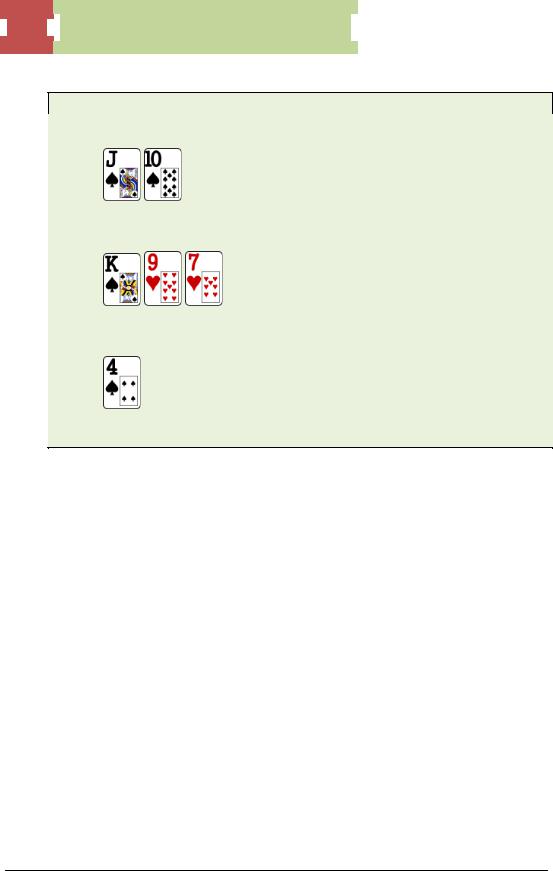
 100
100  Postflop: Time to Play Poker
Postflop: Time to Play Poker
100 NL – 6 max. 100BB effective stacks. You open-raise to $4 from UTG with
and a weak-tight BTN calls. The flop is
You c-bet full-pot and he calls. The turn is a
Bet or check?
Bet. Villain’s range consists of tons of flush and straight draws that will fold to a second barrel. You also picked up an extra 9 outs with your flush draw. A river jack or ten may sometimes give you the best hand against a stubborn A9 or 9sXs/7sXs. A queen or an eight gives you the best hand. Having raised UTG, Villain likely perceives your range to be stronger here than if you were to raise from the button. This increases your fold equity. Be aware that if Villain calls the turn and the river is 2r, you usually have to check-fold even though he rarely has better than Kx, because so many draws missed that he’s going to find a call often. If you have a read that your opponent folds to river bets a lot, then go ahead and bet. With so much money out there by this point, with the chance that he has a draw himself, and with the small chance he’s folding a made hand he called two streets with, a river bet is decent.
Multi-Way Pots
With three or more players in a pot, it’s best to play your draws conservatively, especially when they are non-nut draws. Players typically have a stronger range if they call your flop bet, and it’ll be harder getting them off their hands. Unless you have a monster draw (nut flush draw + OE), just check-fold or check behind. A good rule of thumb is that the less equity you have in the pot, the less you should be betting.
© 2010 Aaron Davis and Tri Nguyen - All Rights Reserved.
http://www.DailyVariance.com
100
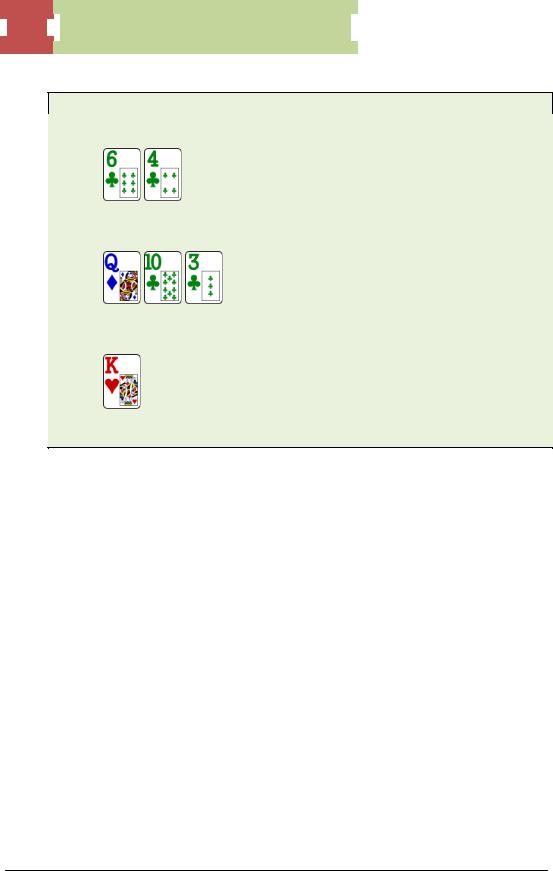
 101
101  Postflop: Time to Play Poker
Postflop: Time to Play Poker
100 NL – 6 max. 100BB effective stacks.
You open-raise to $3 with
from the BTN and both the blinds call. The flop is
You bet full pot and they both call. The turn is a
They check. Should you bet or check?
Check. Although the turn is a scare card, it hits their range quite a bit and improves a lot of their hands. If either of them has J9 or AJ, he now has a straight. Someone may have picked up two pair with KQ or KT. With that in mind, you have very little fold equity against their range, and there is also the chance that your small flush draw might not make the best hand even if you do hit. For these reasons, you should check.
Little Fold Equity
On some boards, you really can’t do anything but check. The turn card probably helps Villain’s range so much that he’ll call again, and then you’ll have to bluff the river too if you want to win the pot.
For example:
© 2010 Aaron Davis and Tri Nguyen - All Rights Reserved.
http://www.DailyVariance.com
101

 102
102  Postflop: Time to Play Poker
Postflop: Time to Play Poker
100 NL – 6 max. 100BB effective stacks. You open-raise to $3.50 with
from the CO and BB calls. The flop is
and he check-calls your 3/4-bet. The turn is a
and he checks. Bet or check?
Check. The turn likely improves his range. If Villain has Kx here, he’s not folding because he will often have KQ, KJs, KTs, and K9s in his range since he defends from the blinds. If he has AQ or QJ, he’ll have a straight draw to go with his pair and he won’t be folding that either.
Another reason to check is that there is a good chance you’ll get check-raised on the turn and have to fold. Players are getting better, so they are defending from the blinds with a stronger range (suited broadway cards). Checking gives you a chance to improve your hand and extract value. If the river is a blank and it is checked to you again, you should consider bluffing the river. He would’ve bet two pair or better on the river, hoping you had a made hand and went for pot control on the turn. He may also have missed draws such as JT or ace-high flush draws that can’t call a river bet.
Bet-Fold
Bet-folding is something I wished I had learned much sooner in my poker career. The idea is simple: you bet with the intention of folding to a raise. This is a great line that can be used to protect a vulnerable hand against draws. Do this with bluffs, semi-bluffs and even good pairs. The significance of this line lies in charging draws, extracting value from worse hands and letting you know when you’re behind.
© 2010 Aaron Davis and Tri Nguyen - All Rights Reserved.
http://www.DailyVariance.com
102
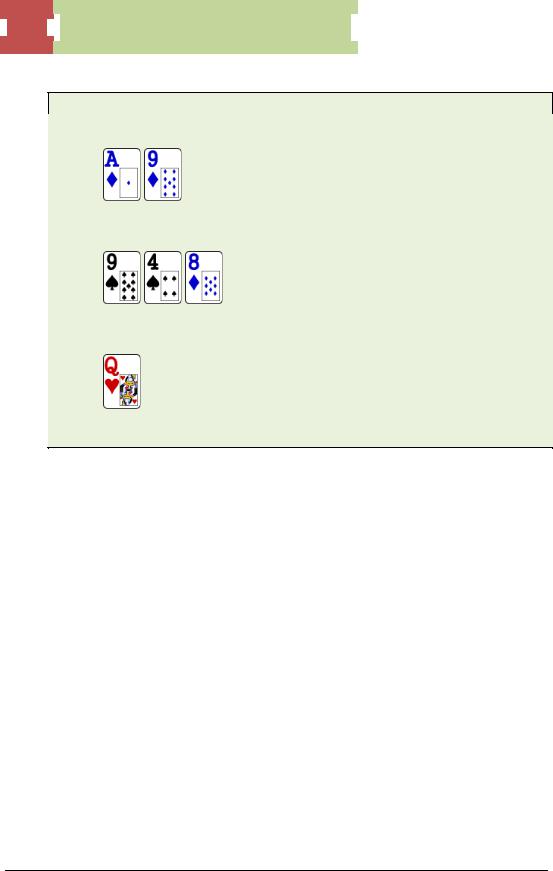
 103
103  Postflop: Time to Play Poker
Postflop: Time to Play Poker
100 NL – 6 max. 100BB effective stacks.
Suppose you open-raise to $3.50 with
from MP and CO calls. The flop is
You bet 3/4-pot and he calls. The turn is a
and you bet 2/3-pot. He raises and you …?
Fold. The turn is a tough spot because your hand is too good to check-fold. On a flop with this many draws, A9 is likely good against most of his range. So you either check-call or bet-fold. Check-calling is a viable option, but you risk giving a free card on a draw-heavy board with a vulnerable hand, and it allows your opponent to put you a hand. This will encourage him to bluff the river more, which is something you don’t want him to do with a marginal holding in a spot where he can easily have stronger hands than yours. Betting allows you to avoid most of these complications.
Betting allows you to charge draws and extract value from 9x or 8x. If Villain has two pair or better, he’ll raise most of the time to try to stack you. There are too many draws for him to be slow-playing. Against a raise, you can be sure your hand is no longer good and you can comfortably fold. There will be situations when you’d rather check behind with your good pair.
© 2010 Aaron Davis and Tri Nguyen - All Rights Reserved.
http://www.DailyVariance.com
103
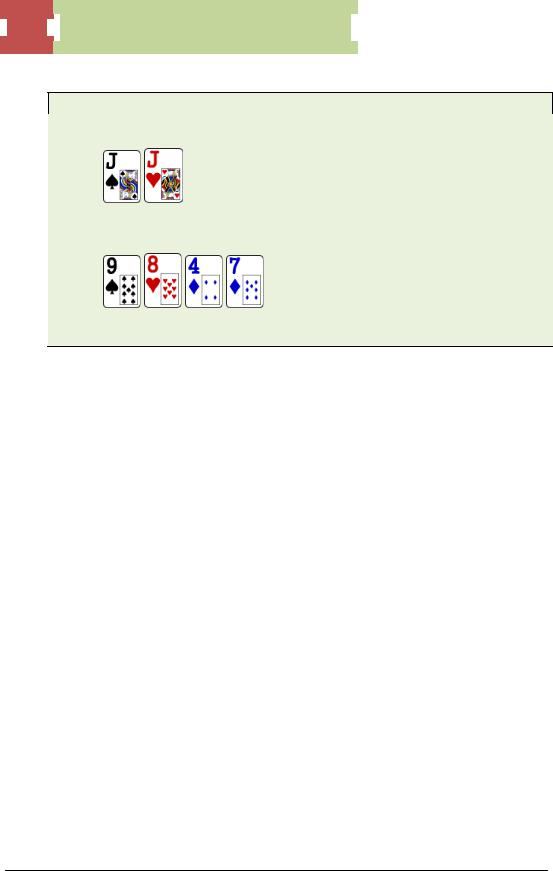
 104
104  Postflop: Time to Play Poker
Postflop: Time to Play Poker
100 NL – 6 max. 100BB effective stacks.
Let’s say you’re in position with
Villain is an aggressive player who is willing to get it in light. The board is
He checks to you. Should you check or fire the second barrel?
Bet. Although it sucks to get check-raised on this turn, you are likely behind if that happens. The best scenario you wish for is that Villain has TT, T9, or a pair with diamonds.
Combine those holdings with made hands such as two pair or better, and you’re crushed. Nevertheless, it‘s a spot where you should bet because Villain has a lot of hands that will check-call a turn bet. Hands such as TT, T9, or a pair with a draw will check-call much more often than check-raise because they don’t need to protect their hands.
Against a tricky, good opponent, I would check behind often here because I wouldn’t know his check-raising range. Once I can determine whether he’s check-shoving this spot with draws, I will have no problem bet-calling. However, the majority of players won’t check-raise this turn often and thus, you should bet-fold with JJ. An interesting question is whether you bet-fold with AA in this spot. The answer is yes, you should. Unless you have a read that your opponent slow-plays pre-flop with big pocket pairs and goes crazy with them post-flop, bet-folding AA is best.
If you are worried about being exploited because you are bet-folding AA here, don’t. AA isn’t the top of your turn betting range. You can easily have two pair, sets and straights in your range. Of course, if you feel your opponent is check-raising the turn a lot against you, then it’s an easy bet-call on future hands. However, with the way players construct their turn check-raising range, I wouldn’t lose sleep if I bet-folded AA on the turn.
© 2010 Aaron Davis and Tri Nguyen - All Rights Reserved.
http://www.DailyVariance.com
104
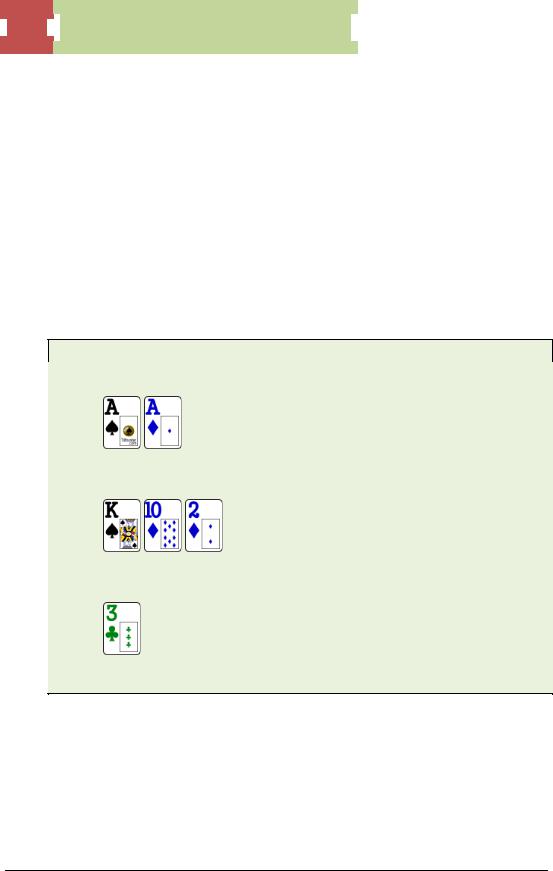
 105
105  Postflop: Time to Play Poker
Postflop: Time to Play Poker
Bet Sizing—Setting Up For a Shove
One of the most common problems of smalland micro-stakes players is bet-sizing. They have a strong hand they want to go all-in with. So they bet or raise and somehow end up with 80BB at the river in a 50BB pot.
Other times they end up with such a small stack that bluffing the river becomes ineffective. Suppose the pot is 90BB and they have 40BB left. If they bluff all-in, Villain will call much more often because of such great pot odds. The ideal stack size you should have by the time you commit yourself should be two-third to a full pot size. If you are a few big blinds over or under, that’s fine.
Let’s see how we can employ bet-sizing in our favor in a few situations.
Hand #1: 100 NL – 6 max. 100BB effective stacks.
Everyone folds to the button and he raises to $6. You 3-bet to $24 with
from the small blind, and he calls. The pot is now $49. You c-bet $20.
He calls. The turn is a
The pot is now $89. You have $56 left for roughly a 3/5-pot shove on the turn.
© 2010 Aaron Davis and Tri Nguyen - All Rights Reserved.
http://www.DailyVariance.com
105
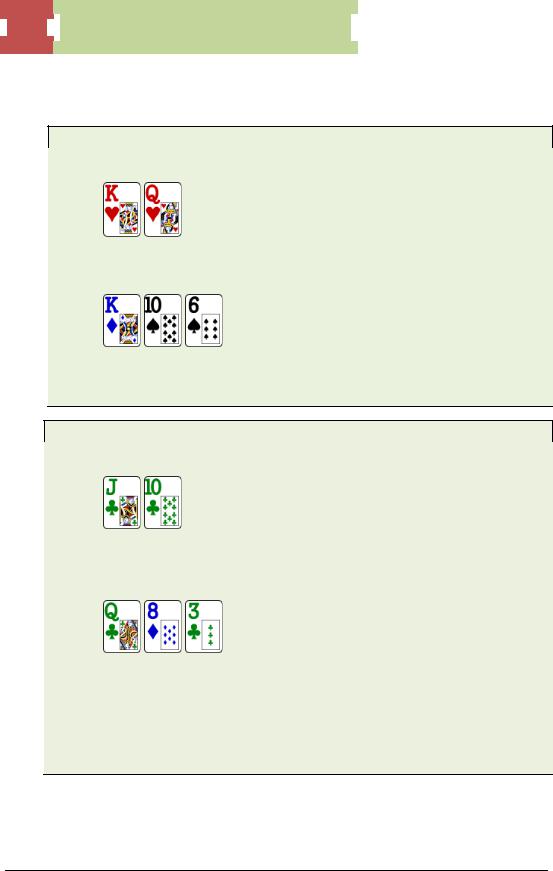
 106
106  Postflop: Time to Play Poker
Postflop: Time to Play Poker
Hand #2: 100 NL – 6 max. 100BB effective stacks.
The button open-raises $4. You reraise to $14 from the small blind with
and he calls. The pot is $29 ($14 + $14 + $1). You c-bet 3/4-pot ($21.75) on
and he calls. The pot is now $72.50 ($21.75 + $21.75 + $29). You have $64.25 left for nearly a pot-sized shove. Perfect sizing.
Hand #3: 100 NL – 6 max. 100BB effective stacks.
You’re on the button with
MP raises to $4 and you call from the BTN. The pot is $9.50 ($4 + $4 + $1.5). The flop is
and he bets $8. You raise to $20 and he calls. The pot is now $49.50 ($9.50 + $20 + $20). You have $76 left on the turn and the pot is roughly $50. It’s a pretty awkward spot because you have 1.5 times the pot size. Shoving isn’t bad, but it’s not as good as having a full pot-sized bet left. Had you raised to $24-28 on the flop, you would have had just the right size to shove on the turn.
An important note regarding bet sizing is to remember to cater to the fish. In other words, if you are playing against a bad player who is also a calling station, don’t use standard bet
© 2010 Aaron Davis and Tri Nguyen - All Rights Reserved.
http://www.DailyVariance.com
106
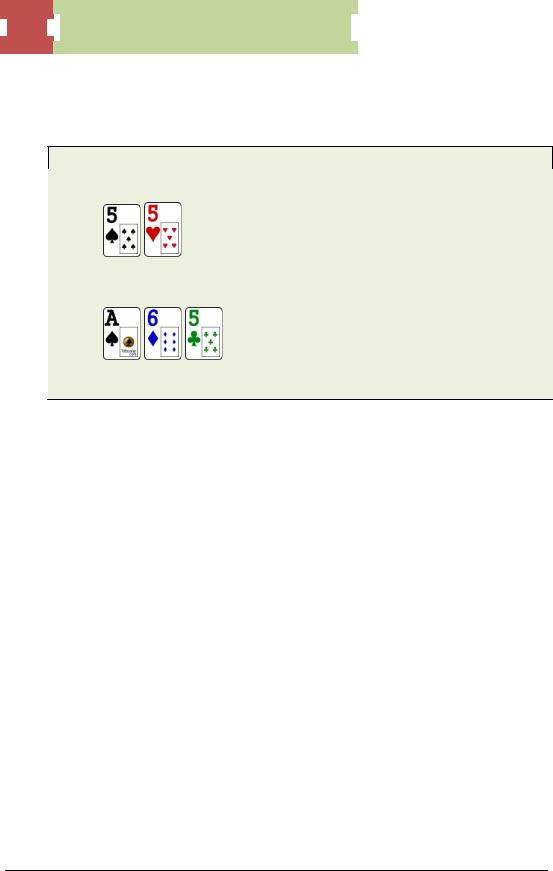
 107
107  Postflop: Time to Play Poker
Postflop: Time to Play Poker
sizes. I have seen many students leave money on the table because they fail to extract maximum value from their hands.
100 NL – 6 max. 120BB effective stacks.
Let’s say you open-raise to $3.50 from the CO with
and the fish from the blind calls. The flop is
The fish donk bet $6. What should you raise to?
You should raise really big in this spot. Fish don’t like to fold, so if he has an ace, he’s going to call no matter what. In this hand, you should make it at least $25 to go. You want to build the pot so that it’s tougher for Villain to fold in later streets. A mistake I see all the time is to raise to $15 to keep the fish in. If he has anything he likes, he will call and you have a chance to stack him. If he has air, he’s not going to call a small raise. Of course, against a regular player, I would never make it $25 to go because it is so tough for me to balance this in future hands. I want to be able to bluff-raise this flop sometimes, so I will make a small raise with my strong hands.
Another common mistake my students make involves incorrect bet sizes against fish who call too much on the flop and turn. My students would bet a standard 2/3-pot on the flop and turn. This bet sizing bloats the pot so that a bad player will have a hard time folding a pair on the river. A more efficient betting pattern against bad players who like to call a lot on earlier streets is to bet 1/3-pot on the flop and turn and 2/3-pot on the river. There are two reasons for this. First, it keeps the pot small at the river so that players are less inclined to call your river bet because there’s less money out there. Second, they will get to the river with wide ranges and will often fold to a big bet.
© 2010 Aaron Davis and Tri Nguyen - All Rights Reserved.
http://www.DailyVariance.com
107

 108
108  Postflop: Time to Play Poker
Postflop: Time to Play Poker
Important Note: Knowing how to play well against a fish is probably the most important skill because at the end of the day, that’s where the majority of your winnings will come from. Being able to play well against regulars is good, but being able to play well against fish is even better.
© 2010 Aaron Davis and Tri Nguyen - All Rights Reserved.
http://www.DailyVariance.com
108
